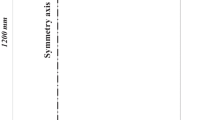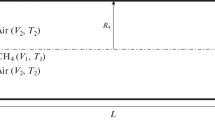Abstract
Based on the particle equilibrium approximation and introducing a prespecified probability density function of the bimodal type, we have developed a method for calculation of the rate of NO formation in turbulent combustion of a premixed gas mixture, taking into account the pulsations in temperature and composition caused by the chaotic motion of the thin reaction zone, the superequilibrium concentration of oxygen atoms, and the energy losses to radiation. Based on the numerical results, we have compared the effects of the listed factors on the rate of nitrogen oxide formation.
Similar content being viewed by others
References
Yu. Ya. Buriko, “Study of nitrogen oxide formation in turbulent flames of the jet type,” Dissertation in competition for the academic degree of Candidate of Physical and Mathematical Sciences Moscow (1984).
V. R. Kuznetsov and V. A. Sabel'nikov, Turbulence and Combustion [in Russian], Nauka, Moscow (1986).
J. B. Moss and K. N. C. Bray, “A statistical model of NO formation in premixed turbulent flames,” in: Proceedings, Second European Symposium on Combustion, The Combustion Institute, French Section, Chatillon (1975), pp. 315–332.
P. Moreau and R. Borghi, “Experimental and theoretical studies of nitrogen oxide formation in a turbulent premixed flame,” J. Energy,5, No. 3, 152–157 (1981).
S. B. Pope, “Monte Carlo calculations of premixed turbulent flames,” in: Eighteenth Symposium (International) on Combustion, The Combustion Institute, Pittsburgh (1981), pp. 1001–1010.
P. A. Libby and F. A. Williams (eds.), Turbulent Flows of Reactive Gases [Russian translation], Mir, Moscow (1983).
W. Kollmann (ed.), Calculation Methods for Turbulent Flows [Russian translation], Mir, Moscow (1984).
H. B. Mason and D. B. Spalding, “Prediction of reaction rates in turbulent premixed boundary-layer flows,” in: The Combustion Institute European Symposium, F. J. Weinberg (ed.), Academic Press, New York, (1973), pp. 601–606.
Ya. B. Zel'dovich, P. Ya. Sadovnikov, and D. A. Frank-Kamenetskii Oxidation of Nitrogen in Combustion [in Russian], Izdat. Akad. Nauk SSSR, Moscow (1947).
C. T. Bowman, “Investigation of nitric oxide formation kinetics in combustion processes: the hydrogen-oxygen-nitrogen system,” Combust. Sci. Technol.,3, No. 1, 37–45 (1971).
A. N. Lipatnikov, I. P. Nazarov, and V. N. Prostov, “Correction for heat loss in modeling turbulent combustion of a premixed mixture,” Fiz. Goreniya Vzryva,24, No. 3, 32–35 (1988).
J. Ay, and M. Sichel, “Theoretical analysis of NO formation near the primary reaction zone in methane combustion,” Combust. Flame,26, No. 1, 1–15 (1976).
Additional information
Dolgoprudnyi. Translated from Fizika Goreniya i Vzryva, Vol. 29, No. 3, pp. 78–81, May–June, 1993.
Rights and permissions
About this article
Cite this article
Lipatnikov, A.N. Numerical modeling of nitrogen oxide formation in turbulent combustion of a premixed gas mixture. Combust Explos Shock Waves 29, 326–330 (1993). https://doi.org/10.1007/BF00797651
Issue Date:
DOI: https://doi.org/10.1007/BF00797651




